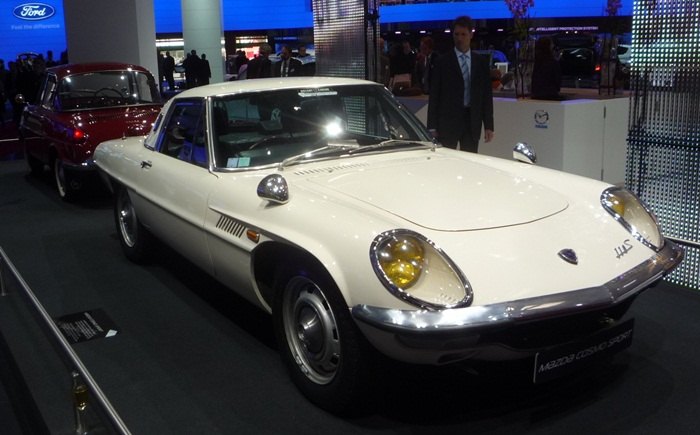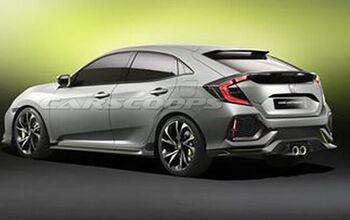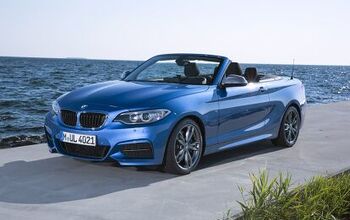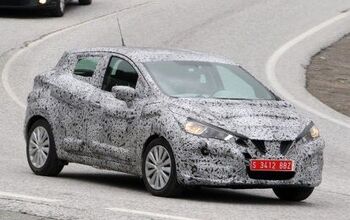Paris Auto Show: A Walk And Talk About Cars
You don’t need TTAC to tell you what’s new at this year’s Paris auto show. If you want the re-hashed-yet-excited PR-based bits about the newest 515 HP sports car concept, or if you want to hear about which electric cars VW will maybe/probably/possibly introduce in 2014, and how great they already are at this very moment, then you probably know where to go.
Yet there is, undoubtedly, plenty of stuff from Paris worth writing about. For any car nut, the place is a Xanadu. Especially for me personally, when the opportunity presented itself to see the Paris show with one of my very favorite automotive writers (and I’m not just saying that because he’s the boss’ father), Paul Niedermeyer. Here’s an (edited, because you don’t want to spend the next three hours reading this), highly subjective conversation between two car fans. – Martin Schwoerer
Martin: So Paul, what do think you’ll find exciting here in Paris?
Paul: Well, you know, I like old cars, so its probably not surprising that the first car that catches my eye as we walk in is that delightful Mazda Cosmo. I have to confess that I wish I had gone to the 1968 Paris Auto Show when I was feverish about new cars like the Lamborghini Miura and the Mercedes 300 SEL 6.3. But Forty-two years later is better then never. I will try to stay in the present, and am curious as to what direction the industry is taking, and what catches my eye.
Martin: I just like looking at wacky cars – there is something about Paris and Tokyo that designers tend to feel inspired to let their wildest ideas roam free. Nowadays, even Paris is commercial, so we’ll see… I am also looking forward to seeing the new Focus in the flesh. I also like electrics and I look forward to some test drives, like with the Renault Fluence and the Nissan Leaf.
Paul: There’s definitely electricity in the air here; it appears that if you’re a manufacturer and don’t have an EV production car or concept to show here, you’re at risk of looking like…your batteries are run down.
Martin: Whoa, here we are at Mercedes. Say, Paul, how do you like the new CLS and what’s your take on Mercedes’s new styling language?
Paul: Well, I don’t much like the current S-Class…and the new CLS even less. It’s too blingy. They just don’t look that classy or exceptional anymore. When it’s hard to tell a Benz from a Hyundai at first glance, you know the automotive world has really changed. The thrill is gone, at least for me.
Martin: I think it’s just a kind of tragedy. The previous CLS was an interesting and new take on “how to make a car for midlife-crisis guys with money who don’t want a sports car”. It created a new segment – the kinda-practical coupé. Is the new one better-looking in any way? I’d say, no: the new CLS just shows how lost the company is. It has an oddly aggressive, insectoid face and all kinds of odd and hectic creases in places that could use some quiet.
The press says that Mercedes’ styling boss Gorden Wagener is re-defining the company’s products and wants Mercedes to have “more emotional design”. But what does that mean, exactly? Why are faux-heritage bulges around the rear wheels emotional? Where exactly is the emotion in having creases everywhere? It just looks busy and confused to me. I’d call it “tired and emotional” design, if you’ll allow me to use the British expression for being inebriated. I think the Gordenized Mercedes are a product of some misunderstanding that Dr Dieter picked up in Detroit, to wit: that when you make something blingy, when you make it badass, you are making it emotionally attractive to the New Hedonists – the boomers who are in the position to lease expensive and unpractical cars. That may be, but it kills the brand for all the rest of us.
Paul: Agreed. The lowly and fairly clean C-Class may be the most successful current Mercedes, looks-wise. But the world is changing: Mercedes once appealed to those that wanted the very finest-built automobile, whether that was a luxury car or a durable four-cylinder diesel. That market has disappeared, leaving MB to chase new ones. Can you imagine someone wanting to stretch themselves financially to buy a CLS because they planned to keep it for twenty years?
Martin: The thing is, you’ll never know exactly how successful the new CLS is. Around 70% of this market segment in Europe consists of company cars. They’re leased at possibly cut-rate prices to meet sales targets, and only after three or so years do they get dumped at market rates. If somebody has the power to make himself look good, he’ll push volume. You might get a massive write-off at some point, but they won’t say “we are posting losses because our cars haven’t been selling, because they look sucky”.
Let me take a picture of you in front of the Renault Twizy. Could you imagine one of those in the States?
Paul: Well, having just seen how popular scooters (and the three-wheel variants) are here in Paris, I see how the Twizy and other concepts similar to it here will make sense for a certain segment here and in other European cities. It’s a step up from a scooter, period…
The US? No way, except maybe, in a few cities like SF, Portland and Seattle…Eugene?
Martin: I agree it’s a no-go in the U.S: people are just too scared of crashing against a Hummer. But picture this. An affordable car you can squeeze next to the two cars that are already in your driveway. A good drive, because it has its batteries underfloor, making for a low center of gravity. “Fuel” costs totaling around $1,600 for 100,000 miles. And no need to car pool, because you can’t… At least it’s easier for me to picture than the Nissan Townpod. It’s like they looked at the Cube and said “it’s OK, but it needs smaller windows!”
Paul: Yes, because smaller windows make so much sense in a city car!? Of course, if we’d have been here in 1968, we’d be laughing at the other extreme, that glass cube on wheels, the Qausar Unipower. Is there a happy medium?
Martin: And the Kia Pop? I like bench seats – but in a car that looks like a paper clip?
Paul: In the ever-more crowded field of urban EV runabouts, I guess the designers are a bit desperate to stand out. At least it has decent visibility! And I love that purple upholstery.
Martin: But I find it impressive how with the Optima, Kia is no longer copying VW: it’s now copying Lexus, and not without success. Just look at the C-pillar! What do you think?
Paul: The handsome Optima is generating a lot of interest here; the Kia stand, along with the Hyundai one, are perhaps the two most crowded ones I’ve seen. It’s a reflection of the remarkable leap forward these two have made. Who could have predicted that even ten years ago? It’s truly rare to see a car company leap from something everyone chuckled about, to one that everyone is taking very serious, like these two German car execs in the picture above. Watch out!
Martin: Here we are at Lotus. It’s ironic, wouldn’t you say? Lotus had an over-wide, unpractical supercar in the 1970s – the Esprit. Then it turned a new leaf in the early 1990s, with the true-to-philosophy, lightweight, unique Elise. Does the new Elite Concept “supercar” mean that Lotus is no longer a maker of pure, efficient sports cars? I don’t know – maybe the new design just clinics better in Saudi Arabia?
Paul: I suppose the Elise family is reaching a saturation point. Realistically, older tall guys like me can only admire it from the outside unless they’ve just walked out of a Bikram hot yoga class. So I guess they’re doing the same thing everyone else eventually does: brand extension. When will the Lotus SUV and four door sedan appear?
Martin: Speaking of wide-body cars that probably clinic well in Saudi Arabia, I do like how BMW’s new 6-series now has chrome on the lower grille. And I appreciate how one can sum-up BMW’s management philosophy in one short sentence: “We make cars that are fun to drive and don’t break down so often, at the same time we’re hedging the future with lightweight materials and electric technology.” I just wish they looked more European and catered less to the taste of rich antisocial types.
Paul: Clearly, the luxury car makers are thinking ever more of China and other growth markets. I doubt they’re holding clinics in Las Vegas or Phoenix. Just as well, though, now that I think about what I’ve just said! I certainly like this 6-series more than its predecessor; cleaner, more classic, less Bangled. And I’m not so sure about your “antisocial types” comment; BMWs do pretty well with rich liberals, at least in the US! We do have those here, odd as it may seem.
Martin: But since this is a European show, let’s see what’s going on with Peugeot. This is the world premiere of their Diesel Hybrid system, which might make sense if Toyota’s Atkinson-cycle engines were somehow really weak or not all that economical at higher speeds. But they aren’t, so it doesn’t, I think. So why go for Diesel? Just to reap the benefits of lower tax on fuel (per energy unit, in Europe)? To get slightly better fuel economy at a constant 90 mph? For the four-wheel-drive? I don’t get it. What do you say?
Paul: I’m not sure that I’ve noticed a non-diesel French cars on the streets of Paris of recent vintage; it seems like they all are. The tax break certainly distorts the market, and that is undoubtedly what motivated Peugeot. Having the rear electric motor completely separate from the front engine is an interesting and pragmatic choice. It would make it fairly easy to adapt to other engines, including gas. I rather like it, but it will be interesting to see how well it works and if the economics are viable, given the double (cost) premium of both the diesel engine and the electric components. I suspect this approach was also cheaper to engineer, rather than develop a new transmission to incorporate both motors.
Martin: Paul, you like cars that are compact, good to sit in with enough headroom for Frankenstein, and look nice. So you might like Peugeot’s HR-1 concept. It’s shorter than a Fiesta, has plenty of space for three, looks funky, has a good amount of ground clearance, and looks realistic (not too expensive). They say it’s a new segment – the stylish micro-SUV. What’s your take?
Paul: Clearly, the SUV influence has filtered down to every class of car. I have mixed feelings about them in general, but this one displays it more successfully than some. Just the ticket for hopping curbs in the city center. It just needs bush bars for the European inner-city parking space wars.
Martin: It seems you fit inside the electric Peugeot iOn (identical with Mitsubishi iMiEV and Citroen C-Zero). How’s the feel from the driver’s viewpoint?
Paul: Excellent. I’ve been wanting to see one of these in the flesh for way too long. I think the Mitsubishi is a superbly designed one-box urban car. And sitting in it only confirms that: it’s very roomy given the small footprint, and has very good visibility. A perfect city car for four. It is narrow, to meet Japanese kei-car standards, but its not a problem, for me, anyway. But Mitsubishi has already said that the export version, at least to the US, will have a wider body, to accommodate beefier Americans.
Martin: Ah, here’s the Rolls-Royce Ghost. I sort of like it, because it is somewhat discrete and unassuming, in a 1970’s Silver-Shadow sort of way. The Phantom, in contrast, says “I am so powerful I can bankrupt your country”, which is no longer the thing to do. I think if you’re going to go all plutocratic, you should be more eccentric, like the Phantom Drophead Coupe is, which tells the world you’ve got all you want and don’t care what anybody says.
Paul: The Ghost is ok; it certainly succeeds in fulfilling its mission, to compete against the Bentley Continental. I’m slightly disappointed that RR decided to go “downscale”, but certainly understand why. I actually quite like the Phantom Coupe, especially that weird windshield/A pillar. It reminds me of the eccentric and exclusive coach-built coupes of the thirties, whose designers felt the freedom to explore new ideas and designs. It says: “I don’t give a shit what you think; who are you anyway to even offer an opinion?”
Here we are at Saab. Do you think they’ll survive?
Martin: Well, I’ll tell you: I’m an avid investor, and I think at the moment you could short any maker of smart phones except for Apple and Android franchises, because they all based on the wrong technology and have shrinking market shares. But I’d never try to bet on a car company going down. Because you’ll always find a government that will keep a zombie car maker going. I mean, who really needs all these brands? Would the world really miss Saab, or Opel, or Vauxhall, or Fiat? Now that a Fiesta rides better than any small Peugeot, who needs ’em? Just look at the Saab 9-5: it’s another one of these executive cars that don’t have that much room inside. Huh? It’s supposed to make you feel good while it makes your family feel miserable? Talk about new hedonism…
Paul: Feel good? It’s like sitting in a coal mine: wall-to-wall black.
I’m not sure I agree with you about Saab’s future. I’m not so sure Sweden really cares that much. But then…never underestimate the whims of governments. Yes, there are way too many brands, especially when you have Hyundai/Kia and other new brands coming on so strong.
And Lancia? Well, they do have the sexiest models; I mean the girls (booth babes). But unless they come with the cars, I don’t see much future for them either.
Martin: Here we are at Ford. And here’s the Focus. Nice! It could have been a generic one-box design, but they added just the right amount of creases and effects (like the triangular sub-grilles) to make it recognizable… Typically for Ford, it shows attention to layout detail: sitting in the back, there is enough space for me to put my feet under the front seats… But the dashboard is messy. Tell me, why do designers think us grown-ups want to have dozens of buttons to play with? Are they insinuating we are a bunch of fastidious and fussy Felix Ungers who like to spend days learning how to use a mountain of gadgets? A real put-off for me.
Paul: For an electronic gadget Luddite like me, it’s a major turn-off. Toyota seems to know this, at least for the cars that tend to appeal to the older demographic, like the Camry. I fear it will only get worse. That’s one of the reasons I don’t review new cars that often: most reviews now spend half their time talking about the interface, etc., and very little attention goes to mechanical aspects. Understandably, of course, because they’re increasingly all the same under the skin anyway. And the skins are often all too similar too. Here I go again!
It’s my dilemma; in 1968, cars were so distinctly different mechanically and stylistically. Well, I need to qualify that: in Europe, more so anyway. It was an exciting time of exploring dramatic new forms, solutions and directions. That’s mostly over now: a new Lamborghini is not really all that different in concept than the Miura, which was so revolutionary then. Electric drive is the one really new thing, and I’m glad for that alone, regardless of how practical it is just yet. Would you mind if we stop and look at that Cosmo again on the way out, Martin?
Latest Car Reviews
Read moreLatest Product Reviews
Read moreRecent Comments
- Analoggrotto Level 50 Trolling at it's finest. Well done.
- Lorenzo The unspoken killer is that batteries can't be repaired after a fender-bender and the cars are totaled by insurance companies. Very quickly, insurance premiums will be bigger than the the monthly payment, killing all sales. People will be snapping up all the clunkers Tim Healey can find.
- Lorenzo Massachusetts - with the start/finish line at the tip of Cape Cod.
- RHD Welcome to TTAH/K, also known as TTAUC (The truth about used cars). There is a hell of a lot of interesting auto news that does not make it to this website.
- Jkross22 EV makers are hosed. How much bigger is the EV market right now than it already is? Tesla is holding all the cards... existing customer base, no dealers to contend with, largest EV fleet and the only one with a reliable (although more crowded) charging network when you're on the road. They're also the most agile with pricing. I have no idea what BMW, Audi, H/K and Merc are thinking and their sales reflect that. Tesla isn't for me, but I see the appeal. They are the EV for people who really just want a Tesla, which is most EV customers. Rivian and Polestar and Lucid are all in trouble. They'll likely have to be acquired to survive. They probably know it too.


















































Comments
Join the conversation
It seems too many automakers are focused on eye-candy and convoluted, confusing designs. Maybe we've reached the "end of the road" as auto technology goes, since all cars do the basics reasonably well. Too many brands? Definitely. The market should've shaken many of them out by now, but as long as there are investors willing to hang on to the slim thread of hope and spend others' money, it may not happen for a while. Still too much clinging to heritage brands when the world is drastically different from 40 years ago.
Very thought provoking comment about someone stretching for a CLS to be run for 20 years, but does it hurt MB if they stretch and own for a long time or stretch, get upstaged by neighbors or co-workers and so dump it and stretch again? Seems like that phenomenon has only partially corrected in the recession and is still very present. While the former is certainly more respectable, it seems to be a relic.